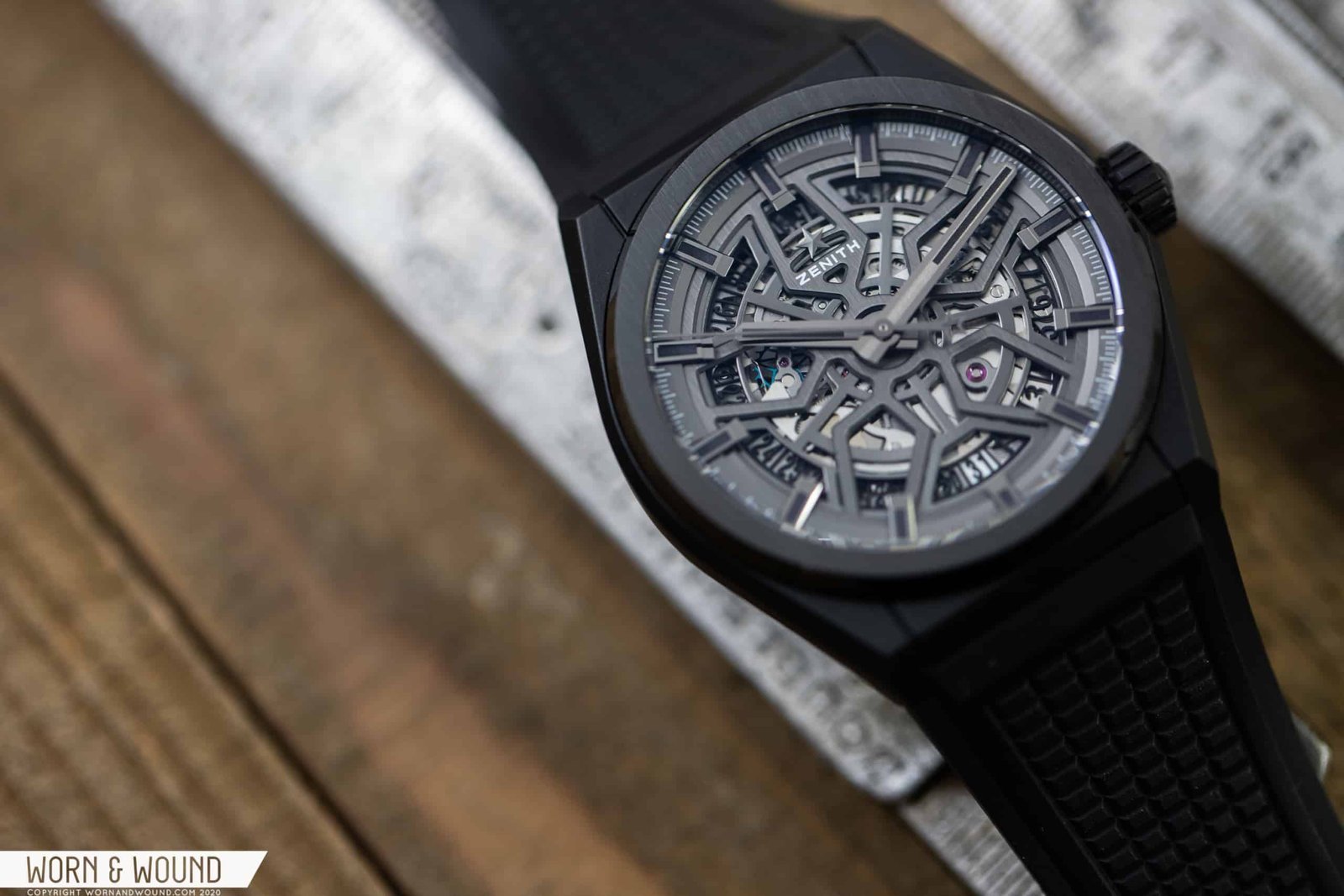There’s no sports watch that I have a stronger connection to than the Zenith Defy. I’ve long told anyone who would listen that the Defy is, bar none, my favorite sports watch collection. From its inception, the Defy has been a watch associated with pushing both design and watchmaking boundaries, through the use of uncommon materials, avant-garde designs, and over-the-top specs. For whatever sports watch from a major Swiss brand you can name, I could probably think of a Defy that matches it in terms of what it can do, and eclipses it in terms of the always hard to quantify cool factor. Yes, of course this is subjective. But, I mean, is it really?
Now that we’ve established that I love the Defy potentially all out of proportion, we can consider the latest entry in the growing collection, the Defy Skyline Chronograph Skeleton. This is a combination of words that were always meant to meet in the form of a Defy – the writing has been on the wall since the intro of the first Defy Skyline, or least since the introduction of the Skyline Chronograph. One of the nice things about the Defy, as a collection, is that it truly offers a different flavor of the core watch for every taste, with dials that are skeletonized, or not, cases that are made from steel, or ceramic, and now chronographs offering some of those same decision points.

My feelings on the Defy Skyline collection oscillate quite a bit. Whenever I put one on, I can’t help but compare it in my mind to the Defy Classic, a now retired Defy platform of thin sports watches running on Elite movements that were beloved by collectors in their day but perhaps not as widely appreciated as they could or should have been. This was an era during which Zenith was pushing various Chronomaster revivals particularly hard, and the Defy, as it often is in Zenith’s history, got a little lost in the shuffle.
Anyway, the Classic is a special watch, and I, once upon a time, owned the ceramic, skeletonized variant, in black. The Defy Classic could really be defined by its thinness, a trait that the Skyline lacks. What I can never quite decide when I have a Skyline on the wrist is whether I like the increased overall chunkiness. It’s a very well constructed and finished case and in the way big watches sometimes can, it has a commanding and sporty presence, where the Classic, by comparison, is sleek and could easily disappear. That heft is something I’m not always in the mood for, which means the Skyline could never really be an everyday watch for me, but I have to concede it could very easily be exactly that for a watch enthusiast with a different preference.

Wearing the Defy Skyline Chronograph Skeleton, it occurred to me that this might actually be the ideal Skyline, and the one that makes the most sensible use of its size. It’s a chronograph, obviously, so it can immediately be forgiven at least some of that extra size. And one of the benefits of a skeletonized dial is that it makes just about any watch, including this one, feel a little more airy.
In terms of raw numbers, the Chronograph Skeleton measures 42mm in diameter and 12.7mm tall, but it wears a bit larger in my opinion because of the angular case with its steep case walls. There are things Zenith could have done to hide the size a bit or make it feel and look smaller (clever finishing, adding more rounded elements to the design, etc.) but they’ve elected not to do that, and I think it’s worth identifying that there’s probably a logical reason for this, namely that Zenith believes their customers want bigger watches. If you’re looking for evidence that the pendulum is swinging away from the small to medium sized watch trend we’ve been clocking over the past few years, Zenith discontinuing the Defy Classic in favor of the Skyline is exhibit A.

The case is impressive from a purely visual standpoint even if you happen to find it a tough size to pull off, but the strongest aspect of this watch is the execution of the chronograph on the skeleton dial. Skeletonization is something Zenith is really great at, whether we’re talking about watches in the Defy collection, or something that might be considered a bit more pedestrian, like the many renditions of the Chronomaster Open that have been introduced through the years, a line that has often been neglected by enthusiasts but nevertheless executes perfectly on its mission to reveal the inner workings of the high frequency regulating organ within the chrono. The secret to these skeletonized dials is that all of the time telling elements sit above the skeletonized dial element, which is always in the shape of the classic Zenith star logo. So you get a view into the movement and the “busy” look of a skeleton dial but the time telling elements that you need to see in order to not make yourself crazy when checking the time float above all of that.
The chronograph subdials follow this design cue and are highly legible in a bright contrasting white against both the blue and black dial variants. There’s nothing complicated or radical about this decision, it’s just smart, and makes reading a dial like this as easy as it possibly could be. In terms of the color options available, I tend to lean toward the blue, which is a little more playful and, I think, makes the most of the inherent zaniness of a watch like this. The black dial is, obviously, sober by comparison. There’s nothing wrong with it, really, but if you’re going to wear a watch like this, you might as well lean into the absurdity of it all, and that means adding a bit of color when you can.

Everything else about the Defy Skyline Chronograph Skeleton matches previous iterations of the Skyline. The bracelet is very comfortable and articulates nicely, and the included rubber strap is similarly comfortable and easy to wear. Finishing is industrial in its aesthetic but well done, and it makes sense on a watch like this which is not really indebted, necessarily, to traditions of fine watchmaking. This is a watch, as are all Defys, that is forward looking and even somewhat futuristic.
The Defy release schedule follows a predictable pattern going back to the Classic era. Steel watches, followed by skeleton versions, followed by ceramic. And while I’m certain that any new Defy Skylines will be as rock solid as any previous versions of the watch, I can’t help but wonder what else is out there in the world of Defy. Do they all have to be Skylines? One of the real charms of vintage Defy collecting is that huge variety of case shapes. This was often where the Zenith design team would really display their taste for the avant-garde, so it’s a bit of a shame, and not at all in keeping with the Defy tradition, that all Defys are effectively made on the Skyline platform, save the Extreme and the 21, which are frankly still pretty close. If I had one wish for the collection, it would be to bring in new case shapes (outside of the Revival pieces) that reinterpret some of the more off-the-wall ideas of the Defy in the 1970s.
The retail price of the Defy Skyline Chronograph Skeleton is $15,500. Obviously, that’s a lot of money to spend on any watch, but it makes a certain amount of sense when you consider other high end chronographs from big luxury brands. The Rolex Daytona comparison is tiresome, perhaps, but necessary, as it’s still the most sought after luxury chronograph on the market. If you can get one at retail, you’re paying exactly the same price as this Skyline’s MSRP, and an argument can be made that the movement is better in the Zenith and the styling more original and unique (they are obviously completely different, and maybe not likely to be seriously cross shopped).

I would never go so far as to say that a watch like this represents good value at its five figure price point, but at a time when we’re seeing brands hike up prices almost arbitrarily without offering significantly better quality, I don’t think $15,500 is obscene for a high frequency chronograph with a skeletonized dial that’s part of one of the most historic sports watch lines in watchmaking (your mileage may vary on how important the Defy of it all is to you, I suppose). That said, with the potential combinations of what a modern Defy can be nearing its endpoint when it comes to the Skyline, I’m more interested in what’s next than in exploring every possible iteration of the current generation. Zenith













